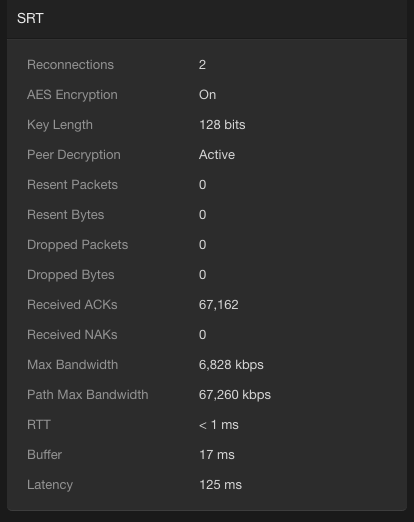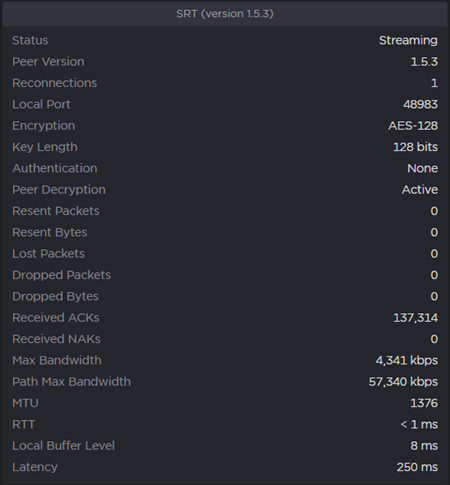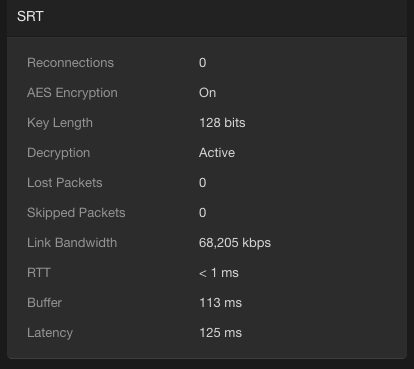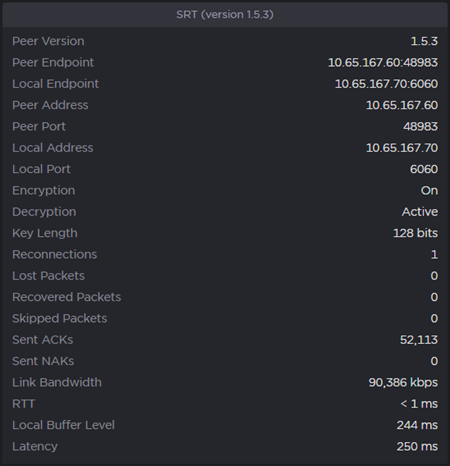SRT
The SRT section provides a detailed look at the SRT traffic.
Makito X/X4 Encoder (SRT source device)
Makito X/X4 Decoder (SRT destination device)
| Src | Dest | Parameter | Description |
|---|---|---|---|
| ✓ | Status | The current operating status of the stream. | |
| ✓ | ✓ | Peer Version | The SRT version used for the connection. |
| ✓ | ✓ | Reconnections | Number of reconnections since the stream started. Severe network congestion may cause the connection to drop, but it will be automatically reconnected if less than ~1 second. |
| ✓ | ✓ | Encryption | Indicates status of AES Encryption (if enabled). |
| ✓ | ✓ | Key Length | Indicates the specified key length for AES encryption. |
| ✓ | Peer Decryption | Indicates whether or not the SRT stream is being successfully decrypted. | |
| ✓ | Decryption | Indicates whether or not the SRT stream is being successfully decrypted. | |
| ✓ | Resent Packets | Number of packets retransmitted based on reports from the destination device (or lack thereof). | |
| ✓ | Resent Bytes | Total bytes retransmitted. | |
| ✓ | Dropped Packets | Number of packets reported missing by the destination device. This is the raw number of packets dropped by the network. These packets may be recovered by retransmission by the source device, and so do not necessarily result in any video artifacts. | |
| ✓ | Dropped Bytes | Number of dropped bytes. | |
| ✓ | Lost Packets | Number of packets reported missing by the decoder. | |
| ✓ | Skipped Packets | Packets that have arrived at the destination device too late, or that never arrive at all. If the “time to play” for a packet has passed, and it is either not at the decoder or arrives after the content it is associated with has already played, that packet is reported as “skipped” on the destination device. Usually this results in some type of video artifact (a replayed frame or video blocking). | |
| ✓ | Received ACKs | Total number of acknowledgment packets received from the destination device (this is a measure of transmission progress). | |
| ✓ | Received NAKs | Total number of negative acknowledgment packets received from the destination device. | |
| ✓ | Link Bandwidth | Estimated maximum bandwidth available as viewed from the destination device | |
| ✓ | Max Bandwidth | Maximum bandwidth used by the source device for this SRT stream (i.e. the current total of audio/video bit rate plus ancillary data plus the SRT Bandwidth Overhead). | |
| ✓ | Path Max Bandwidth | The same value as Link Bandwidth. The destination device sends the value to the source device with an acknowledgment packet. | |
| ✓ | ✓ | RTT | Round Trip Time (RTT) is the time it would take for a packet to travel from a specific source to a specific destination and back again. In SRT, this is measured as the time it takes for the destination device to send an acknowledgment (ACK) packet, and then receive a corresponding confirmation (ACKACK) packet. |
| ✓ | ✓ | Local Buffer Level | Size of an SRT buffer (in milliseconds). The SRT source device’s buffer contains unacknowledged stream packets (those whose reception has not been confirmed by the destination device). The size of the source device buffer, in the absence of congestion or packet loss, is around the RTT value. In the presence of recoverable packet loss, the value should be between those for RTT and Latency. The SRT destination device’s buffer contains stream packets received and waiting to be forwarded or decoded. This statistic shows the portion of the destination device’s buffer up to the first missing packet (i.e. the time remaining for the retransmission of the missing packet before it’s too late). The value of the destination device buffer in the absence of packet loss is just below the latency value. In the presence of packet loss, it is between 0 and the latency value. Note that if you change the bit rate from 6 to 2 Mb/s, the byte count will change but a 2 second buffer will remain 2 seconds. |
| ✓ | ✓ | Latency | A fixed value (from 80 to 8000 ms) representing the maximum buffer size available for managing SRT packets. Values can be entered on both the source and destination devices. When the handshake occurs at the initiation of an SRT streaming session, the higher of the two values is implemented on both devices. The destination default is set to the minimum (80 ms) so that the value can be controlled from the source. The default latency value on the source is 125 ms. |
What to look for:
- If you start to see lots of reconnections, this is an indication that there is a problem with the communication channel between devices.
- A steadily increasing number of NAKs indicates a problem.
- It's normal to see a few dropped packets, but there should not be too many. A low number of dropped packets indicates you are using your bandwidth optimally.
- If the number of Skipped Packets increments slowly, the best thing to do is increase the SRT Latency. If it increments in large jumps, the best thing to do is to lower the video bitrate, or to increase the Bandwidth Overhead % if you have available capacity.
Tip
When adjusting the SRT parameters, ignore any spikes or other variations that appear on the Statistics charts at the time of the change.




